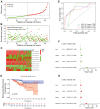An Immune-Related lncRNA Signature to Predict the Biochemical Recurrence and Immune Landscape in Prostate Cancer
- PMID: 34876840
- PMCID: PMC8643172
- DOI: 10.2147/IJGM.S336757
An Immune-Related lncRNA Signature to Predict the Biochemical Recurrence and Immune Landscape in Prostate Cancer
Abstract
Purpose: This study aims to construct an immune-related signature to provide comprehensive insights into the immune landscape of prostate cancer, which can predict biochemical recurrence (BCR) and clinical treatment.
Methods: Based on The Cancer Genome Atlas (TCGA) dataset, a signature constructed by DEirlncRNAs pairs was determined. The receiver operating characteristic curve analysis, Kaplan-Meier analysis, nomogram, and decision curve analysis were used to analyze it. Then, immunophenoscore (IPS), immune cell infiltration, tumor mutation burden (TMB), and immune function were investigated. Finally, we evaluated the role of the signature in medical treatment.
Results: A signature constructed by 10 valid DEirlncRNAs pairs was identified in the training set and validated well in the testing and entire set. The signature was a reliable and independent prognostic indicator to predict the BCR of prostate cancer, which was better than the clinicopathological characteristics. After dividing the patients into low- and high-risk groups by median value, we found that the high-risk group had shorter BCR-free time and higher TMB levels. Furthermore, the high-risk group was negatively associated with plasma B cells and CD+8 T cells. IPS and immune functions, such as immune checkpoints and human leukocyte antigen, were significantly different between the two groups. Low-risk group was more sensitive to endocrine therapy and immunotherapy, while high-risk group was more inclined to targeted drugs. Both groups had their own sensitive chemotherapy.
Conclusion: We established a novel signature to predict BCR and validated its role in the immune landscape of prostate cancer, which could help patients receive personalized medical treatment.
Keywords: TMB; biochemical recurrence; immune landscape; lncRNA; medical treatment; prostate cancer.
© 2021 Zhang and Luo.
Conflict of interest statement
The authors report no conflicts of interest in this work.
Figures












Similar articles
-
A cuproptosis-related LncRNA signature: Integrated analysis associated with biochemical recurrence and immune landscape in prostate cancer.Front Genet. 2023 Feb 24;14:1096783. doi: 10.3389/fgene.2023.1096783. eCollection 2023. Front Genet. 2023. PMID: 36911392 Free PMC article.
-
Development and validation of novel inflammatory response-related gene signature to predict prostate cancer recurrence and response to immune checkpoint therapy.Math Biosci Eng. 2022 Aug 9;19(11):11345-11366. doi: 10.3934/mbe.2022528. Math Biosci Eng. 2022. PMID: 36124593
-
Identification and Validation of a Prognostic 5-Protein Signature for Biochemical Recurrence Following Radical Prostatectomy for Prostate Cancer.Front Surg. 2021 May 31;8:665115. doi: 10.3389/fsurg.2021.665115. eCollection 2021. Front Surg. 2021. PMID: 34136527 Free PMC article.
-
A Novel Set of Immune-associated Gene Signature predicts Biochemical Recurrence in Localized Prostate Cancer Patients after Radical Prostatectomy.J Cancer. 2021 May 1;12(12):3715-3725. doi: 10.7150/jca.51059. eCollection 2021. J Cancer. 2021. PMID: 33995646 Free PMC article.
-
Identification of a DNA Repair Gene Signature and Establishment of a Prognostic Nomogram Predicting Biochemical-Recurrence-Free Survival of Prostate Cancer.Front Mol Biosci. 2021 Mar 11;8:608369. doi: 10.3389/fmolb.2021.608369. eCollection 2021. Front Mol Biosci. 2021. PMID: 33778002 Free PMC article.
Cited by
-
Castration-resistant prostate cancer monitoring by cell-free circulating biomarkers.Front Oncol. 2024 Sep 10;14:1394292. doi: 10.3389/fonc.2024.1394292. eCollection 2024. Front Oncol. 2024. PMID: 39319053 Free PMC article. Review.
-
Utilizing Liquid-liquid phase separation-related lncRNAs to predict the prognosis and treatment response of PCa.Discov Oncol. 2024 Aug 16;15(1):352. doi: 10.1007/s12672-024-01226-3. Discov Oncol. 2024. PMID: 39150479 Free PMC article.
-
Novel gene signature for predicting biochemical recurrence-free survival of prostate cancer and PRAME modulates prostate cancer progression.Am J Cancer Res. 2023 Jul 15;13(7):2861-2877. eCollection 2023. Am J Cancer Res. 2023. PMID: 37559989 Free PMC article.
References
LinkOut - more resources
Full Text Sources

